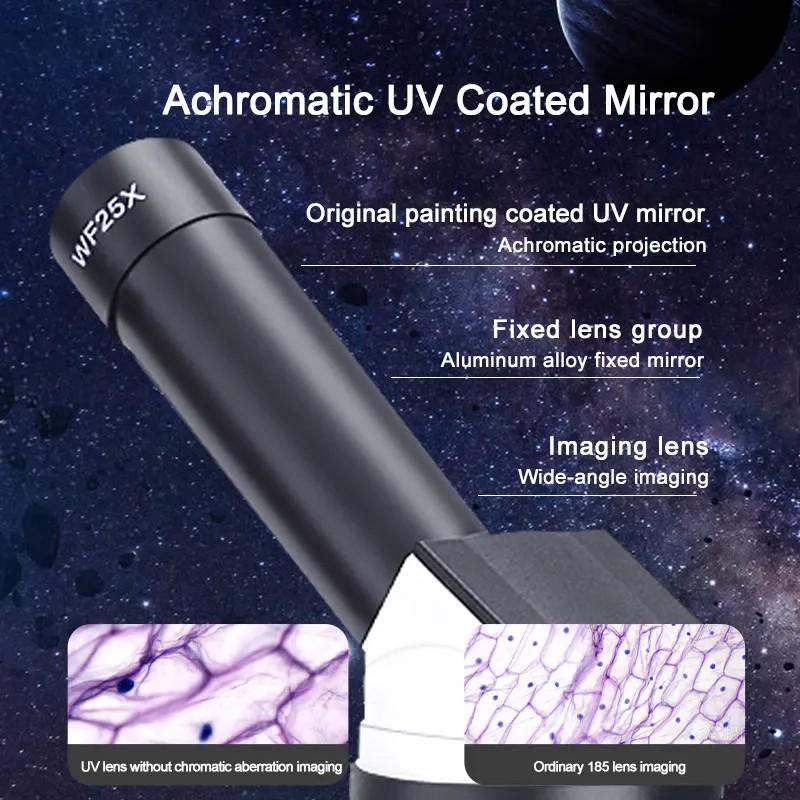What Magnification Microscope To See Bacteria ?
To see bacteria under a microscope, a magnification of at least 400x is typically recommended. This level of magnification allows for a clear view of the bacteria cells and their structures. However, it is important to note that the optimal magnification may vary depending on the specific type of bacteria being observed and the microscope being used. In some cases, higher magnifications, such as 1000x, may be necessary to observe smaller or more detailed features of certain bacteria. Additionally, the use of oil immersion techniques can further enhance the resolution and clarity of bacterial cells under high magnification.
1、 Optical Microscopes: Up to 1000x magnification for observing bacteria.
Optical Microscopes: Up to 1000x magnification for observing bacteria.
Optical microscopes have long been used as a valuable tool in microbiology to observe and study bacteria. These microscopes use visible light and a series of lenses to magnify the image of the specimen being observed. The magnification power of an optical microscope is determined by the combination of the objective lens and the eyepiece.
When it comes to observing bacteria, optical microscopes with magnifications of up to 1000x are commonly used. This level of magnification allows scientists to see bacteria in detail, including their shape, size, and arrangement. It enables them to study the morphology and structure of bacteria, which is crucial for identification and classification purposes.
However, it is important to note that the magnification power alone is not the only factor that determines the ability to observe bacteria. The resolution of the microscope also plays a significant role. Resolution refers to the ability of the microscope to distinguish between two closely spaced objects as separate entities. A higher resolution allows for clearer and more detailed images.
In recent years, there have been advancements in optical microscopy techniques that have further enhanced the ability to observe bacteria. For example, the development of fluorescence microscopy has allowed scientists to label specific components of bacteria with fluorescent dyes, making them easier to visualize. Additionally, confocal microscopy has enabled the imaging of bacteria in three dimensions, providing a more comprehensive understanding of their structure and behavior.
In conclusion, optical microscopes with magnifications of up to 1000x are commonly used to observe bacteria. However, it is important to consider other factors such as resolution and the use of advanced microscopy techniques to obtain clearer and more detailed images. These advancements continue to push the boundaries of our understanding of bacteria and their role in various biological processes.

2、 Electron Microscopes: Up to 100,000x magnification for detailed bacteria visualization.
What magnification microscope to see bacteria? Electron Microscopes: Up to 100,000x magnification for detailed bacteria visualization.
When it comes to observing bacteria, electron microscopes are the most powerful tools available. These microscopes use a beam of electrons instead of light to magnify the specimen, allowing for much higher resolution and magnification than traditional light microscopes.
Electron microscopes can achieve magnifications of up to 100,000x, which is essential for visualizing bacteria in great detail. At this level of magnification, individual bacterial cells and their structures can be observed, providing valuable insights into their morphology and behavior.
The high magnification of electron microscopes is particularly useful for studying the ultrastructure of bacteria. It allows researchers to examine the intricate details of bacterial cell walls, flagella, pili, and other appendages. This level of resolution is crucial for understanding the mechanisms of bacterial pathogenesis, as well as for identifying and characterizing different bacterial species.
It is important to note that while electron microscopes offer exceptional magnification, they also have some limitations. Sample preparation for electron microscopy can be complex and time-consuming, requiring specialized techniques such as fixation, dehydration, and staining. Additionally, electron microscopes are expensive and require a controlled environment, making them less accessible than light microscopes.
In recent years, advancements in electron microscopy techniques have further improved the visualization of bacteria. Cryo-electron microscopy, for example, allows samples to be imaged at extremely low temperatures, preserving their native structures. This technique has revolutionized the field of structural biology and has provided unprecedented insights into the molecular architecture of bacterial cells.
In conclusion, electron microscopes with magnifications of up to 100,000x are the ideal choice for visualizing bacteria in great detail. They offer the resolution necessary to study the ultrastructure of bacterial cells and provide valuable insights into their morphology and behavior. With ongoing advancements in electron microscopy techniques, our understanding of bacteria and their role in various biological processes continues to expand.

3、 Light Microscopes: Typically 400-1000x magnification for bacteria observation.
Light Microscopes: Typically 400-1000x magnification for bacteria observation. However, it is important to note that the magnification required to see bacteria may vary depending on the specific type of bacteria and the purpose of observation.
Light microscopes are commonly used to observe bacteria due to their ease of use, affordability, and versatility. These microscopes use visible light to illuminate the specimen and magnify it for observation. The magnification range of 400-1000x is generally sufficient to visualize bacteria, which are typically between 0.2 to 2 micrometers in size.
At lower magnifications (around 400x), light microscopes can provide an overview of bacterial colonies, allowing researchers to observe their shape, arrangement, and general characteristics. As the magnification increases, finer details of individual bacteria become visible, such as their cellular structures, flagella, or pili.
It is worth mentioning that higher magnifications, such as 1000x, may require the use of immersion oil to improve resolution and clarity. Immersion oil has a refractive index similar to glass, reducing light refraction and increasing the numerical aperture of the objective lens, resulting in sharper images.
While light microscopes are widely used for bacterial observation, it is important to acknowledge that they have limitations. Some bacteria may be too small or transparent to be adequately visualized even at higher magnifications. In such cases, electron microscopes, which offer much higher magnifications and resolution, may be necessary.
In conclusion, light microscopes with magnifications ranging from 400-1000x are typically sufficient for observing bacteria. However, the specific magnification required may vary depending on the type of bacteria and the level of detail needed for the observation.

4、 Phase-Contrast Microscopes: Enhances contrast for better bacteria visibility.
Phase-Contrast Microscopes: Enhances contrast for better bacteria visibility.
Phase-contrast microscopy is a valuable technique used to visualize bacteria and other transparent specimens. Unlike brightfield microscopy, which relies on differences in light absorption to create contrast, phase-contrast microscopy enhances contrast by exploiting differences in refractive index. This technique allows for the visualization of unstained, live bacteria without the need for complex staining procedures.
When it comes to the magnification required to see bacteria using a phase-contrast microscope, it depends on the size of the bacteria and the level of detail one wishes to observe. Bacteria are typically in the range of 0.2 to 10 micrometers in size, with most falling between 0.5 and 5 micrometers. To visualize bacteria at the cellular level, a magnification of at least 1000x is recommended. This level of magnification allows for the observation of individual bacterial cells and their internal structures.
However, it is important to note that simply increasing the magnification does not guarantee better visibility of bacteria. Other factors, such as the numerical aperture of the objective lens and the quality of the microscope optics, also play a crucial role in achieving clear and detailed images. Additionally, the use of appropriate lighting techniques, such as Köhler illumination, can further enhance the visibility of bacteria under a phase-contrast microscope.
It is worth mentioning that recent advancements in microscopy technology, such as super-resolution microscopy, have pushed the boundaries of bacterial visualization. These techniques allow for the observation of bacteria at the nanoscale level, providing unprecedented detail of their structures and interactions. However, these advanced techniques often require specialized equipment and expertise.
In conclusion, a phase-contrast microscope with a magnification of at least 1000x is recommended for the visualization of bacteria. However, it is important to consider other factors, such as the numerical aperture and quality of the microscope optics, to ensure optimal visibility. Additionally, advancements in microscopy technology continue to expand our understanding of bacteria, allowing for the observation of structures at the nanoscale level.




























